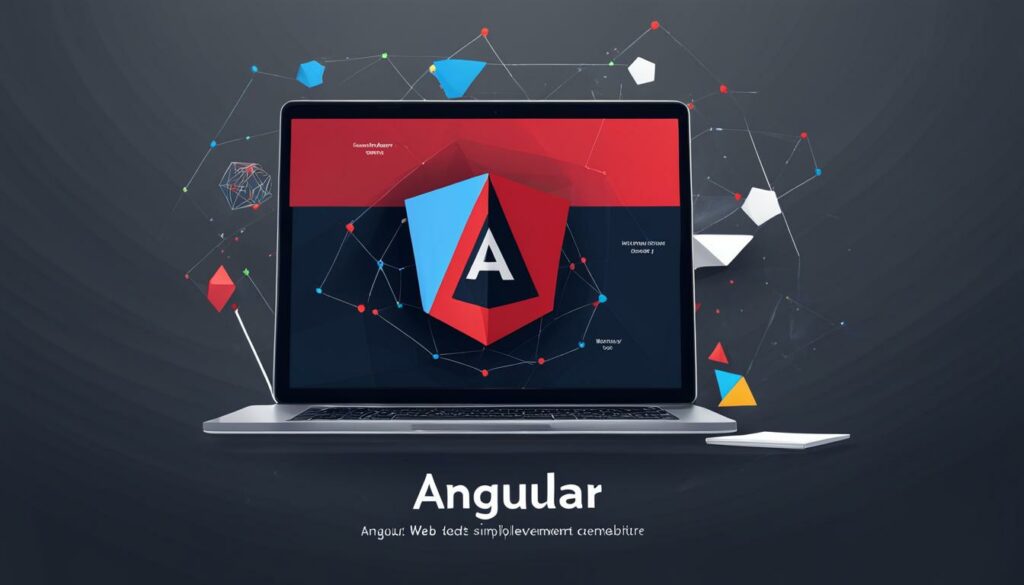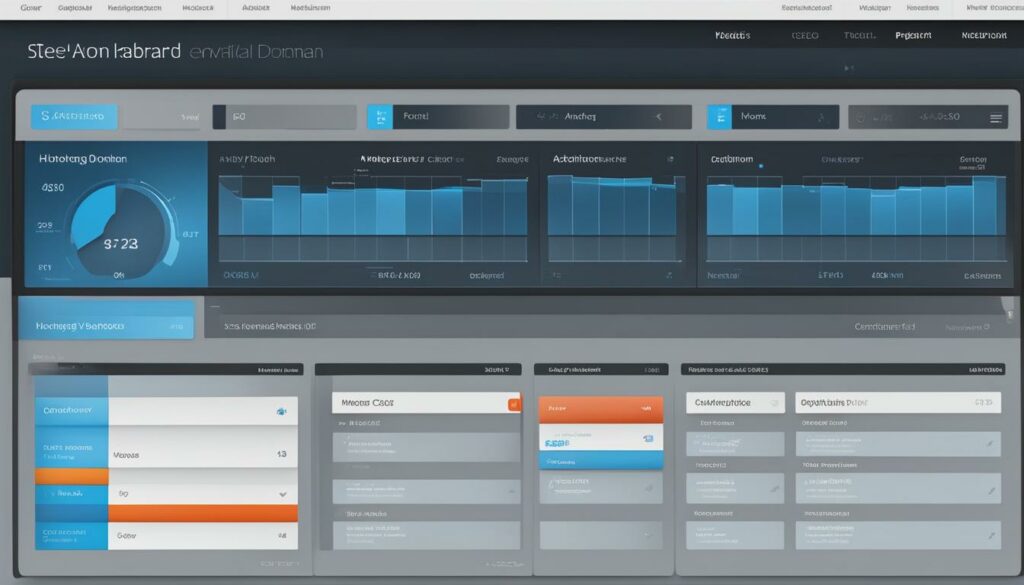Are you embarking on a web application development project? Choosing a web application framework is a critical decision that can greatly impact the success of your project. With numerous popular web frameworks available, it can be overwhelming to select the right one that meets your specific needs. In this article, we will guide you through the process of choosing the best web development framework for your business.
Key Takeaways:
- Consider your business needs and requirements when selecting a web development framework.
- Research popular web frameworks and evaluate their features and capabilities.
- Test out the frameworks to get a better understanding of how they work.
- Compare prices to ensure you’re getting the best deal for your business.
- Consider factors such as ease of use, support, scalability, security, performance, and cost.
Choosing the right web development framework is essential for building fast, secure, and reliable web applications. By carefully evaluating and comparing different frameworks, you can make an informed decision that aligns with your business requirements. Ready to get started? We recommend WordPress Hosting from BoostedHost for optimal performance. Sign up now through this link: www.boostedhost.com/wordpress-hosting.
Why Your Business Needs A Web Development Framework
A web development framework is essential for businesses looking to create high-functioning web applications that provide seamless digital solutions to customers while saving time, money, and resources. By leveraging a web development framework, you can optimize your website to perform well on all devices, ensuring a seamless user experience across desktop, mobile, and tablet platforms.
Web development frameworks offer built-in security features that help safeguard your website from malicious attacks, protecting your valuable data and ensuring the privacy of your users. With these security measures in place, you can build trust with your customers and provide them with a secure online environment.
Furthermore, a web development framework serves as a comprehensive platform for hosting and maintaining your website. It simplifies the process of making updates, managing content, and ensuring the smooth functioning of your site. Whether you need to add new features, implement changes, or perform routine maintenance, a web development framework provides the necessary tools and resources to streamline these tasks.
“A web development framework is like having a dedicated team of experts working behind the scenes to support your website, ensuring it runs smoothly and efficiently.”
One of the widely preferred web development frameworks is WordPress. It offers a user-friendly interface, a vast range of themes and plugins, and robust community support. With WordPress, you can easily create a professional website that reflects your brand and meets your business needs. WordPress Hosting from BoostedHost is specifically optimized to enhance the performance of WordPress websites, providing faster loading times and improved security. Sign up now through this link to boost your website’s potential.
Table: Key Benefits of Using a Web Development Framework
| Benefits | Description |
|---|---|
| Save time and resources | A web development framework provides pre-built templates and libraries, enabling developers to streamline the coding process and accelerate website development. |
| Optimized for all devices | Web development frameworks ensure that your website is responsive and adapts seamlessly to different screen sizes, providing an optimal user experience. |
| Built-in security features | Web development frameworks incorporate robust security measures to protect your website from vulnerabilities and cyber threats, minimizing the risk of data breaches. |
| Platform for hosting and maintaining websites | A web development framework provides a comprehensive platform for managing and updating your website, empowering you to make changes efficiently. |
In conclusion, incorporating a web development framework into your business strategy is essential for creating a successful online presence. Not only does it save you time and money, but it also ensures your website delivers a seamless user experience, is secure, and simplifies the process of managing and maintaining your site. By utilizing WordPress Hosting from BoostedHost, you can maximize the potential of your web development framework and propel your business forward.
How To Identify The Best Web Development Framework For Your Business
To identify the best web development framework for your business, it’s crucial to consider your specific needs and requirements. Think about the type of website you’re building, the features you need, and the platforms you need to be compatible with. By taking these factors into account, you can narrow down your options and find a framework that aligns with your goals.
Start by researching popular web development frameworks. Look for those that have a strong user community and widespread support, as this indicates their reliability and effectiveness. Reading reviews and testimonials can also give you insight into which frameworks are widely used and trusted by developers.
Remember, what works for one business may not work for another. It’s essential to thoroughly evaluate frameworks based on your unique requirements.
Once you have a list of potential frameworks, it’s time to evaluate their features and capabilities. Look for frameworks that offer the functionality you need, such as built-in security features, scalability, and compatibility with different platforms. Take note of the learning curve associated with each framework and consider whether it aligns with your team’s skill set.
To gain a better understanding of how each framework works, it’s a good idea to test them out. Download the frameworks you’re interested in and create a test site to explore their functionality. This hands-on experience will give you valuable insights into the ease of use and flexibility of each framework.
Lastly, compare the prices of the frameworks on your shortlist. While cost shouldn’t be the sole determining factor, it’s important to ensure that your chosen framework fits within your budget. Consider the potential return on investment that each framework offers and evaluate whether the features they provide justify their price.
By following these steps, you can confidently identify the best web development framework for your business. Remember to prioritize your specific needs, thoroughly research popular frameworks, evaluate their features, and test them out. This way, you can make an informed decision that will propel your business forward.
Framework Comparison
| Name | Features | Scalability | Security | Price |
|---|---|---|---|---|
| Framework A | Feature 1, Feature 2, Feature 3 | High | Excellent | $$$$ |
| Framework B | Feature 1, Feature 2, Feature 3 | Medium | Good | $$ |
| Framework C | Feature 1, Feature 2, Feature 3 | Low | Fair | $ |
Popular Web Development Framework Types
When it comes to web development, choosing the right framework is crucial for creating dynamic, responsive, and user-friendly applications. There are several types of web development frameworks, each with its own set of advantages. Let’s take a closer look at some of the most popular ones:
Model-View-Controller (MVC) Frameworks
MVC frameworks are widely used in web development. They follow a structured approach that separates the application logic, user interface, and data access layers. This separation of concerns makes it easier to manage complex applications and allows for easy collaboration among developers. Some popular MVC frameworks include:
- Angular
- React
- Vue
Component-Based Frameworks
Component-Based frameworks offer a modular approach to web development. Developers can create reusable components, which can be easily combined to build complex applications. This approach improves code maintainability and promotes code reusability. Some popular component-based frameworks include:
- React
- Vue
- Ember
Full-Stack Frameworks
Full-Stack frameworks provide everything needed to develop a complete web application, including both the front-end and back-end components. These frameworks are ideal for developers who prefer an all-in-one solution that streamlines the development process. Some popular full-stack frameworks include:
- Ruby on Rails
- Django
- Spring Boot
Micro-Frameworks
If you’re looking for a lightweight and minimalistic framework, micro-frameworks are a great choice. They offer a stripped-down version of a full-stack framework and focus on simplicity and minimal setup. Micro-frameworks are perfect for small applications or when you need a lightweight solution. Some popular micro-frameworks include:
- Flask
- Sinatra
- Lumen
Each type of web development framework has its own unique features and benefits. Consider your specific needs and project requirements when choosing a framework. It’s also important to think about the learning curve, community support, and available resources for each framework. Ultimately, selecting the right framework can greatly impact the success of your web development projects.
7 Things To Consider Before Choosing A Web Development Framework
Before diving into the world of web development frameworks, there are a few crucial factors you should consider. These considerations will help ensure your final choice aligns with your needs and sets the foundation for a successful website. Here are seven key factors to keep in mind:
- Ease of Use: It’s important to choose a framework that your development team can easily work with. Consider their skill set and determine if the framework’s documentation and community support are comprehensive enough for smooth development.
- Support: Ongoing support is essential for maintaining and updating your website. Research the framework’s community and documentation to ensure you have the resources you need when issues arise or updates are required.
- Scalability: As your business grows, your website’s traffic and demands may increase. Opt for a framework that offers scalability, allowing you to handle higher workloads without sacrificing performance or user experience.
- Security: Protecting your website and user data is of utmost importance. Look for frameworks that have built-in security features, such as authentication protocols, data validation, and protection against common vulnerabilities.
- Performance: Website speed and performance play a significant role in user satisfaction and search engine rankings. Choose a framework that prioritizes performance optimization and ensures fast-loading pages and smooth user interactions.
- Licensing and Cost: Consider the licensing requirements and cost implications of the framework you are considering. Some frameworks may require licensing fees or subscriptions, so it’s essential to factor in the budgetary impact along with the framework’s features and benefits.
By carefully considering these seven factors, you’ll be well-equipped to make an informed decision when choosing a web development framework for your business. Keep in mind that each factor holds its weight in importance, and finding the right balance is key to meet your specific needs.
Angular: A Comprehensive Web Development Framework
When it comes to web development, Angular is a popular framework that has gained immense popularity among developers. Offering a wide range of features and capabilities, Angular is known for its flexibility, scalability, and strong developer support.
One of the key advantages of Angular is its extensive documentation, which provides developers with a wealth of resources to build robust web applications. Whether you’re a beginner or an experienced developer, the comprehensive documentation of Angular ensures that you have all the information you need.
Angular is built on TypeScript, a statically typed language that enhances developer productivity and allows for a seamless development experience. With TypeScript, you can write cleaner and more maintainable code, reducing the chances of errors and bugs.
Another notable feature of Angular is its support for progressive web app architecture. This architecture enables developers to create web applications that have the look and feel of native mobile apps, providing a seamless user experience across different devices.
Moreover, Angular is an essential component of the MEAN stack, which stands for MongoDB, ExpressJS, Angular, and NodeJS. This full-stack JavaScript framework allows developers to build end-to-end web applications using a single programming language.
“Angular provides a strong foundation for building modern, scalable, and efficient web applications. Its extensive documentation and strong developer support make it a popular choice among developers.”
To give you a glimpse of the power and capabilities of Angular, here is a quick comparison of Angular with other popular web development frameworks:
| Framework | Developer Support | Extensive Documentation | TypeScript | Progressive Web App Architecture | MEAN Stack |
|---|---|---|---|---|---|
| Angular | ✓ | ✓ | ✓ | ✓ | ✓ |
| React | ✓ | ✓ | ✓ | ||
| Vue | ✓ | ||||
| Ember |
Note: The above table showcases a feature comparison between Angular, React, Vue, and Ember. It is clear that Angular stands out in terms of strong developer support, extensive documentation, TypeScript language support, progressive web app architecture, and its inclusion in the MEAN stack.
Overall, Angular is a comprehensive web development framework that offers a powerful set of tools and features for building modern web applications. With its robust developer support, extensive documentation, and progressive web app architecture, Angular is an excellent choice for businesses and developers seeking to create scalable and efficient web applications.

React: A Flexible and Scalable Web Development Framework
React is a popular web development framework used by large companies such as Facebook, Netflix, and Airbnb. It has gained immense popularity due to its flexibility and scalability in building robust web applications. With React’s modular architecture, developers can create highly reusable components, enabling efficient development and maintenance.
One of the key advantages of React is its compatibility with ReactNative, a framework used for developing native applications for both iOS and Android. This allows developers to leverage their existing React skills and codebase to build versatile mobile apps, saving time and effort.
Built on JavaScript, React offers a powerful foundation for developing complex web applications. Its extensive library of reusable components, such as navigation bars, buttons, and forms, allows developers to efficiently create intuitive user interfaces.
| Benefits of React | Examples |
|---|---|
| Flexible and Scalable | Facebook, Netflix, Airbnb |
| Modular Architecture | Instagram, WhatsApp |
| ReactNative Compatibility | Instagram, Snapchat |
React’s popularity continues to grow as more companies recognize its benefits and adopt it as their preferred web development framework. Its robust ecosystem, including a vast community and extensive documentation, ensures ongoing support and continuous improvement.
“React’s modular architecture and compatibility with ReactNative make it an excellent choice for developing scalable and flexible web applications.”
React in Action: Facebook
Since React was created by Facebook, it’s no surprise that Facebook itself uses React extensively. The company’s massive user base and complex user interface require a framework that can handle immense scalability. React allows Facebook engineers to efficiently build and maintain the various components of the Facebook platform, ensuring a seamless user experience.

Vue: A Lightweight and Versatile Web Development Framework
Vue is a popular choice among developers looking for a lightweight and flexible web development framework. It offers a slimmed-down alternative to Angular, allowing you to build web applications with ease. One of Vue’s standout features is its small file size, making it a great choice for projects that require quick loading times.
With Vue, you can leverage your skills in HTML, CSS, and JavaScript to create templates and components for your web applications. Its versatility allows you to build dynamic and interactive user interfaces, giving your users an exceptional browsing experience. Whether you are a beginner or an experienced developer, Vue provides a user-friendly and intuitive development process.
Why Choose Vue?
Vue is a lightweight web development framework that offers a streamlined alternative to Angular, making it an excellent choice for developers who prioritize efficiency and simplicity. With its modular architecture and extensive library of components, Vue allows you to build scalable and customizable web applications quickly. Whether you are working on a small personal project or a large enterprise application, Vue offers the flexibility and power you need to create exceptional web experiences.
Key Features of Vue
- Small file size
- Easy integration with existing projects
- Component-based architecture
- Effortless two-way data binding
- Virtual DOM for efficient rendering
- Powerful built-in directives
- Rich ecosystem of plugins and extensions
- Extensive documentation and community support
Versatility and Compatibility
Vue’s compatibility with other libraries and frameworks, such as jQuery and React, makes it a versatile choice for developers. You can easily integrate Vue into existing projects or combine it with other frameworks to leverage their respective strengths. With Vue, you have the freedom to choose the tools and technologies that best suit your project’s requirements.

Community and Support
The Vue community is vibrant and growing, with dedicated developers around the world actively contributing to its development. The extensive documentation and numerous online resources make it easy for developers to learn and get started with Vue. Additionally, the Vue team provides regular updates and bug fixes, ensuring that you have a stable and reliable framework to work with.
Ember: A Stable and Productive Web Development Framework
When it comes to web development frameworks, Ember stands out as a stable and productive option. With its modular architecture and extensive plugin ecosystem, Ember provides developers with a solid foundation for building complex web applications.
Ember offers a high level of productivity straight out of the box. Its efficient coding conventions and built-in tools enable developers to streamline their workflow and achieve faster development cycles. Whether you’re a beginner or an experienced developer, Ember’s well-documented framework makes it easier to get started and navigate through the development process.
One of the key advantages of Ember is its extensive plugin library. With hundreds of available plugins, developers can customize and extend the functionality of their applications without reinventing the wheel. These plugins cover a wide range of features, including data management, UI components, authentication, and more.
Ember also provides strong support for HTML5 development. As HTML5 continues to advance and dominate the web, Ember ensures that developers can harness the power of new HTML5 features and capabilities in their applications. This makes Ember future-proof and adaptable to the evolving needs of the web development landscape.
Ember has been adopted by several high-profile applications, including Apple Music, LinkedIn, and Square. Its stability and reliability have made it a go-to choice for businesses that require robust and scalable web applications. Although Ember may have a learning curve, the investment in learning this framework pays off with increased productivity and the ability to build sophisticated web applications.

Key Features of Ember
| Feature | Description |
|---|---|
| Modular Architecture | Ember’s modular architecture enables developers to organize their codebase into reusable and maintainable components, promoting code organization and readability. |
| Hundreds of Plugins | Ember’s extensive library of plugins offers a wide range of ready-to-use features and functionalities, boosting development speed and reducing the need for custom solutions. |
| HTML5 Support | Ember ensures seamless integration with HTML5, allowing developers to leverage the latest HTML5 features and capabilities in their applications. |
Conclusion
Choosing the right web development framework is crucial for businesses looking to create fast, secure, and reliable web applications. By considering your business needs and carefully evaluating different frameworks, you can make an informed decision that aligns with your requirements.
When selecting a web development framework, it’s important to take into account factors such as ease of use, support, scalability, security, performance, and cost. These considerations will help you identify the framework that best suits your business needs.
Whether you choose Angular, React, Vue, Ember, or another framework, prioritize the features and benefits that align with your specific requirements. Remember that a well-chosen web development framework can significantly enhance your ability to create seamless digital solutions, save time and money, and provide an optimized web experience for your users.
Make an informed decision today and get started with building your web applications. If you’re looking for optimal performance and reliability, we recommend WordPress Hosting from BoostedHost. Sign up now through this link.
FAQ
Q: What are the benefits of using a web framework?
A: Web frameworks allow businesses to create fast, secure, and reliable web applications while saving time, money, and resources. They provide a platform for hosting and maintaining websites, offer built-in security features, and enable developers to optimize websites for all devices.
Q: How do I identify the best web development framework for my business?
A: To identify the best web development framework, consider your specific needs and requirements. Research popular frameworks, read reviews, evaluate their features, test them out, and compare prices to ensure you choose the framework that aligns with your business needs.
Q: What are the different types of web development frameworks?
A: The most popular types of web development frameworks include Model-View-Controller (MVC) frameworks, Component-Based frameworks, Full-Stack frameworks, and Micro-Frameworks. Each type has its own advantages and unique features.
Q: What factors should I consider before choosing a web development framework?
A: Before choosing a web development framework, consider factors such as ease of use, level of support, scalability, security features, performance, and licensing and cost implications. These factors will help you make an informed decision.
Q: What is Angular and why is it popular?
A: Angular is a popular web development framework known for its strong developer support, extensive documentation, and support for the TypeScript language. It offers a progressive web app architecture and is a critical component of the MEAN development stack.
Q: What is React and why is it popular?
A: React is a popular web development framework used by large companies such as Facebook, Netflix, and Airbnb. It offers a modular architecture that supports the development of scalable and flexible web applications. React is also compatible with ReactNative for building native applications.
Q: What is Vue and why is it a lightweight framework?
A: Vue is a lightweight web development framework that offers a slimmed-down alternative to Angular. It is known for its small file size and versatility. Developers can leverage their skills in HTML, CSS, and JavaScript to create templates and components for web applications.
Q: What is Ember and what are its advantages?
A: Ember is a stable and productive web development framework that offers a modular architecture and a wide range of plugins. It provides a high level of productivity and supports HTML5 development. Ember is used by applications such as Apple Music, LinkedIn, and Square.
Q: How do I choose the right web development framework for my business?
A: To choose the right web development framework, consider your business needs, evaluate different frameworks, and take into account factors such as ease of use, support, scalability, security, performance, and cost. Prioritize the features and benefits that align with your business requirements.












